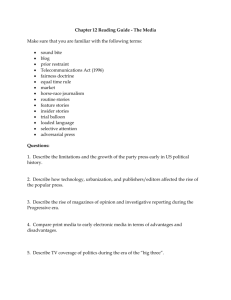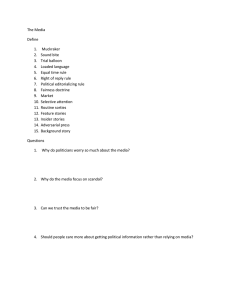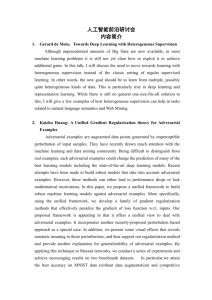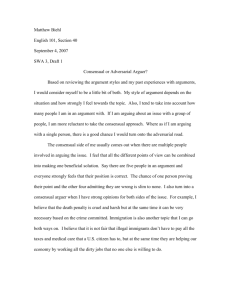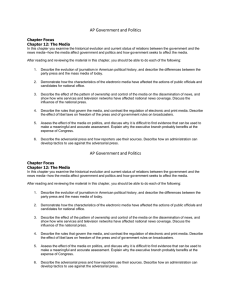The adversarial joint source-channel problem Please share
advertisement
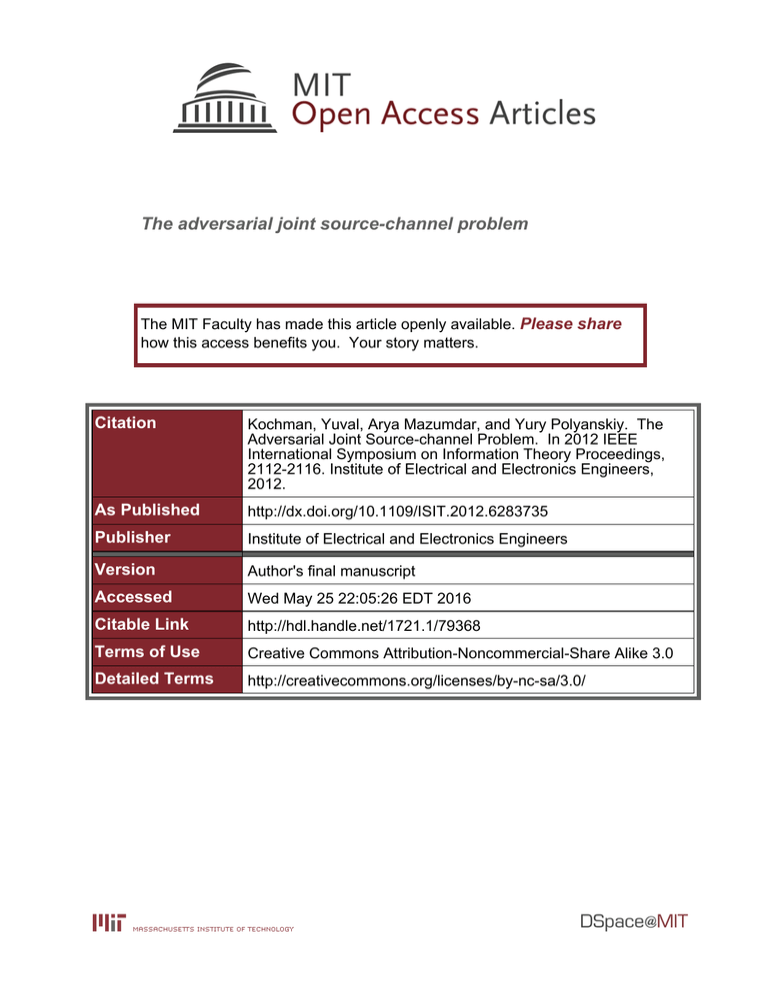
The adversarial joint source-channel problem
The MIT Faculty has made this article openly available. Please share
how this access benefits you. Your story matters.
Citation
Kochman, Yuval, Arya Mazumdar, and Yury Polyanskiy. The
Adversarial Joint Source-channel Problem. In 2012 IEEE
International Symposium on Information Theory Proceedings,
2112-2116. Institute of Electrical and Electronics Engineers,
2012.
As Published
http://dx.doi.org/10.1109/ISIT.2012.6283735
Publisher
Institute of Electrical and Electronics Engineers
Version
Author's final manuscript
Accessed
Wed May 25 22:05:26 EDT 2016
Citable Link
http://hdl.handle.net/1721.1/79368
Terms of Use
Creative Commons Attribution-Noncommercial-Share Alike 3.0
Detailed Terms
http://creativecommons.org/licenses/by-nc-sa/3.0/
The Adversarial Joint Source-Channel Problem
Yuval Kochman, Arya Mazumdar and Yury Polyanskiy
Abstract—This paper introduces the problem of joint sourcechannel coding in the setup where channel errors are adversarial
and the distortion is worst case. Unlike the situation in the
case of stochastic source-channel model, the separation principle
does not hold in adversarial setup. This surprising observation
demonstrates that designing good distortion-correcting codes
cannot be done by serially concatenating good covering codes
with good error-correcting codes. The problem of the joint code
design is addressed and some initial results are offered.
I. I NTRODUCTION
One of the great contributions of Shannon [1] was creation
of tractable and highly descriptive stochastic models for the
signal sources and communication systems. Shortly after, his
work was followed up by Hamming [2], who proposed a
combinatorial variation of the channel coding part. This combinatorial formulation has become universally accepted in the
coding-theoretic community. Similarly, for the case of lossy
compression Shannon [3] proposed a stochastic model and the
rate-distortion formula, while shortly after Kolmogorov followed up with a non-stochastic definition of the ǫ-entropy [4].
The research that followed demonstrated how both ways of
thinking, stochastic and combinatorial, naturally complement
each other, reinforcing intuition and yielding new results.
To the best of our knowledge, in the setup of joint sourcechannel coding, however, only the stochastic approach has
been investigated so far, starting with [1], [3]. This paper aims
to fill in this omission.
In Section II we define the adversarial separate source and
channel coding problems and present known results about
them. Then, we build on these definitions to define the
adversarial joint source channel coding (JSCC) problem. Next,
in Section III we prove asymptotic bounds on the performance
limits of adversarial JSSC codes. It turns out that the celebrated
separation principle [1], [3] does not hold in the adversarial
model. Therefore, the problem of constructing asymptotically
optimal adversarial JSSC codes requires a joint approach
and cannot be solved by combining good compressors with
good error-correcting codes. In Section IV we focus on the
binary case and propose methods for designing such codes
and analyzing their performance.
II. P RELIMINARIES
A. Source coding
A source problem is specified by a source and reproduction
alphabets S, Ŝ, a distribution P on S and a distortion metric
Yuval Kochman is with the School of Computer Science and
Engineering, the Hebrew University of Jerusalem, Jerusalem, Israel.
e-mail: yuvalko@cs.huji.ac.il. Arya Mazumdar and Yury Polyanskiy
are with the Department of Electrical Engineering and Computer Science,
MIT, Cambridge, MA 02139, USA. e-mail: {aryam,yp}@mit.edu.
d : S × Ŝ → R+ . The distortion between a source string sk
and a reproduction ŝk is given by:
△
d(sk , ŝk ) =
k
1X
d(sj , ŝj ) .
k j=1
(1)
In the stochastic setting, an (k, Mk , D)-source code is
specified by a surjective map φ : S k → C for some C ⊆ Ŝ k
such that |C| = Mk and the expected distortion is at most D,
where the mean is taken with S k ∼ P k (memoryless source).
The rate of the source code is defined by 1/k · log Mk and
asymptotically, the best possible rate for the distortion D is
given by [3]:
△
R(P, D) =
min
I(S; Ŝ) .
PŜ|S :E [d(S,Ŝ)]≤D
In the adversarial setting, a source set F ⊆ S k is selected
and then the smallest cardinality of a covering of F upto
distortion D is sought; cf. [4]. Here we restrict ourselves to
the case of F being the set of all source sequences that are
strongly typical1 with respect to the source distribution P .
The adversarial (k, Mk , D) source code is defined by a
collection of Mk points C ⊂ Ŝ k such that for any P typical source sequence sk there exists a point ŝk in C such
that d(sk , ŝk ) ≤ D. The asymptotic fundamental limit of
adversarial source coding is defined to be
△
1
log max{Mk : ∃(k, Mk , D)
k→∞ k
-adversarial source code} .
Rad (P, D) = lim
Not only does this limit exist, but remarkably it coincides with
R(P, D):
Theorem 1 (Berger’s type covering [6]):
Rad (P, D) = R(P, D).
As an example, take S = Ŝ = F2 and P is the uniform
distribution, with the Hamming distortion measure. It is known
that
Rad (P, D) = R(P, D) = 1 − h2 (D),
where h2 (x) = −x log x − (1 − x) log(1 − x) is the binary
entropy function. Indeed the same rate is achievable even if
the source set is entire Fk2 [7].
1 Here
and in the sequel, strong typicality is in the sense of [5, Chapter 2].
B. Channel coding
A channel problem is specified by input2 and output alphabets X , Y, and a conditional distribution W : X → Y.
In the stochastic setting, an (n, M, ǫ)-channel code is
specified by a pair of maps f : {1, . . . , M } → X n and
g : Y n → {1, . . . , M } such that
P[g(Y n ) = i|X n = f (i)] ≥ 1 − ǫ ,
i = 1, . . . , M ,
where PY n |X n = W n (a memoryless channel). The rate of the
code is defined as 1/n · log Mn and asymptotically the largest
achievable rate is given by Shannon capacity [1]:
C(W ) = max I(X; Y ) .
PX
In the adversarial setting, for each input sequence xn ∈ X n
the channel output may be arbitrary within a subset of Y n . We
choose this set to be A(xn ) ⊆ S n , the set of strongly typical
sequences y n given xn with respect to W. The adversarial
(n, Mn ) channel code is defined as a collection of Mn points
C ⊂ X n such that for any pair of different points xn , z n ∈ C,
A(xn ) ∩ A(z n ) = ∅. The asymptotic fundamental limits of
adversarial channel coding are defined to be
1
log max{Mn : ∃(n, Mn )
n
-adversarial channel code}
1
△
C ad (W ) = lim inf log max{Mn : ∃(n, Mn )
n→∞ n
-adversarial channel code} .
△
√
with ĥ(x) = h2 (1/2 − 1/2 1 − x), and the GilbertVarshamov bound [9] is
RGV (δ) = 1 − h2 (2δ).
C. Adversarial JSCC
A JSCC problem is specified by:
• Adversarial source: S, Ŝ, PS , d(·, ·)
• Adversarial channel: X , Y, WY |X .
At source and channel blocklengths (k, n), a JSCC scheme is
specified by:
k
n
• an encoder map S → X
from the source to channel
n
k
input: x = f (s ).
n
• a decoder map Y
→ Ŝ k from the channel output to
k
reconstruction: ŝ = g(y n ).
We say that a JSSC scheme is (k, n, D) adversarial if for
all P -typical source sequence sk and corresponding channel
outputs y n ∈ A(f (sk )), d(sk , g(y n )) ≤ D.
The asymptotically optimal tradeoff between the achievable
distortion and the bandwidth expansion factor ρ = nk is given
by
∗
Dad (ρ) = lim sup inf{D : ∃(k, ⌊ρk⌋, D)
k→∞
C ad (W ) = lim sup
adversarial JSCC} ,
n→∞
(2)
(3)
and similarly for C ad . Therefore, by the classical results on
A(n, d):
(4)
where the MRRW II bound [8] is
RMRRW (δ) =
2A
min
0<α≤1−4δ
1 + ĥ(α2 ) − ĥ(α2 + 4δα + 4δ) , (5)
cost function on X may also be present. We omit it to save space.
one considers the case when the adversary is free to choose
noise vectors e satisfying wt(e) ≤ δn, whereas in our setting the typicality
constrains wt(e) = δn ± o(n). This is asymptotically immaterial, since in
Hamming space two spheres of the same radius are disjoint if and only if the
corresponding balls are.
3 Traditionally,
D∗ad (ρ)
(7)
= lim inf inf{D : ∃(k, ⌊ρk⌋, D)
k→∞
adversarial JSCC} .
Note that because the limits are not known to coincide for
most channels of interest, we have to define both upper and
lower limits.
It is known that C ad (W ) ≤ C(W ). Furthermore, in contrast
to source coding, this inequality is known to be strict in the
next example.
The most studied case of the adversarial channel coding is
that of a binary symmetric channel with crossover probability
δ, BSC(δ). Let A(n, d) be the cardinality of a largest set in Fn2
with minimal Hamming distance between any pair of elements
not smaller than d. We have3 :
1
C ad = lim sup log A(n, 2nδ + 1) ,
n→∞ n
RGV (δ) ≤ C ad (δ) ≤ C ad (δ) ≤ RMRRW (δ) < C(δ),
(6)
(8)
As in the source and channel cases, we use the stochastic
setting performance as a benchmark. In this setting, the source
and channel are i.i.d. according to P = PS and W = WY |X ,
and the requirement is for expected distortion to be at most D.
It is well known that any k-to-n stochastic JSCC must satisfy
[3],
k · R(P, D) ≤ n · C(W ).
(9)
In the asymptotic limit this can be approached, yielding the
asymptotic fundamental limit:
D∗ (ρ) = inf{D : R(P, D) ≤ ρC(W )} .
D. The separation principle
We say that an (k, n) JSCC scheme is separation-based if
for some space M (“the message space”) the encoder consists
of a source encoder fS : S k → M and a channel encoder
fC : M → X n . The decoder consists of a channel decoder
gC : Y n → M and a source decoder M → Ŝ k . Furthermore,
following e.g. [10] we introduce a bijection σ : M → M that
is applied at the encoder and reversed in the decoder, which
is meant to ensure that there the mapping of source messages
to channel ones is arbitrary. The encoder and decoder are thus
given by
f = fS ◦ σ ◦ fC ; g = gC ◦ σ −1 ◦ gS
(10)
where performance is required to hold for any bijection σ.
The asymptotic performance limits of the separation
∗
schemes are denoted as Dad,sep (ρ) and D∗ad,sep (ρ) and defined
in complete analogy with (7) and (8). In the stochastic setting,
the asymptotic performance of the optimal separation scheme
coincides with D∗ (ρ) and thus does not need a special
notation.
III. B OUNDS
ON ADVERSARIAL
C. Binary example
We now combine the binary examples presented in sections
II-A and II-B: the source is binary symmetric with Hamming distortion, and the channel is BSC(δ). The informationtheoretic optimum D∗ (ρ) is given by the solution D to:
JSCC
We start this section with an immediate lower bound on the
fundamental limit of adversarial asymptotic distortion.
Theorem 2 (Converse):
1 − h2 (D) = ρ(1 − h2 (δ))
whenever the r.h.s. is lower than one, zero otherwise. Bounds
on the performance of separation-based schemes are given by
the solutions to:
D∗ad (ρ) ≥ D∗ (ρ) .
Proof: Any adversarial JSCC can be used as a usual
(probabilistic) JSCC, in which case by typicality arguments
it will achieve (maximal) distortion D with vanishing excess
probability (namely, we assume excess distortion whenever the
source or channel behavior are not strongly typical). Thus D
must not be smaller than D∗ (ρ).
1 − h2 (D) = ρ · RMRRW (δ)
1 − h2 (D) = ρ · RGV (δ),
where again the bounds are zero for r.h.s. above one. Since
RMRRW < 1 − h2 (δ) for all δ > 0, it follows that
D∗ad,sep (ρ) > D∗ (ρ) strictly whenever ρRMRRW (δ) < 1.
For ρ = 1 the optimum D∗ (1) is achievable by a trivial
single-letter scheme (namely, the identity encoder and decoder). Therefore, for ρ = 1 and any δ > 0,
∗
D∗ (1) = Dad
(1) < D∗ad,sep (ρ).
A. Separated schemes
Theorem 3 (Separated schemes): If R(P, D) > ρC ad (W )
then
D∗ad,sep (ρ) ≥ D .
(11)
If R(P, D) ≤ ρC ad (W ) then
∗
Dad,sep (ρ) ≤ D .
(12)
We will show shortly, that (11) demonstrates (in special
∗
∗
cases) that Dad,sep
> Dad
.
B. Single-letter schemes
Another special class of JSCC schemes is single-letter
codes. In that case, the mappings f (·) and g(·) are scalar,
and when applied to a block they are computed in parallel
for each entry. Some examples where single-letter schemes
yield the optimum D∗ have been known for a long time, and
Gastpar et al. [11] give the sufficient and necessary conditions
for that to hold.
Theorem 4: If in the stochastic setting a single-letter
scheme achieves some Dsl , then
∗
D ad (1) ≤ Dsl .
(13)
We omit a simple proof of this result, but its essence will
be clear from the example in the next section.
Corollary 5: Whenever single-letter codes are optimal in
the stochastic setting, i.e., Dsl = D∗ (1) we have
∗
Dad (1) = D∗ad (1) = D∗ (1).
Using Theorems 3 and 4, one may find examples in
which single-letter schemes achieve D∗ while separationbased scheme do not, leading to the surprising conclusion that
separation is not optimal in the adversarial setting.
For other values of ρ, separation may also be suboptimal:
Proposition 6: For any positive integer ρ, repetition coding
(i.e., xn is constructed by ρ repetitions of sk ) achieves
asymptotically:
2ρδ
Drep (ρ) =
(14)
1+ρ
∗
By (4) and Theorem 3, it is easy to see that Dad,sep (ρ) =
= 1/2 whenever δ = 1/4. Thus, comparing
with (14) and by continuity for any positive integer ρ there is
an interval of δ for which simple repetition coding outperforms
any separation-based scheme.
D∗ad,sep (ρ)
IV. B INARY SYMMETRIC SOURCE - CHANNEL (BSSC)
In this section we slightly change the problem definition, in
order to make it closer in spirit to that of traditional approach
taken in the coding-theoretic literature for the Hamming space.
Namely, we drop the strong typicality constraints on the source
and the channel. Instead, we let the source outputs be any
binary sequences in Fk2 , while the (adversarial) channel is
allowed to flip up to δn bits.
Definition 1: A (k, n, D) adversarial JSSC code for the
BSSC(δ) is a pair of maps f : Fk2 → Fn2 , g : Fn2 → Fk2
such that
wt(x + g(f (x) + e)) ≤ kD ,
for all x ∈ Fk2 and all wt(e) ≤ δn. The asymptotic fundamen∗
tal limits Dad (ρ) and D∗ad (ρ) are defined as in (7)-(8).
Note that while in channel coding the two definitions lead
to similar results (recall Footnote 3), it is not clear whether the
same holds for JSCC. For example, in Proposition 6, for even
ρ the decoding relies on the fact that the adversary must flip
approximately δn bits, and if this assumption does not hold,
repetition with even expansion ρ is equivalent to repetition
with expansion ρ − 1 followed by channel uses that can be
ignored.
A. Information theoretic converse
D. The optimal decoder for BSSC
Note that by Theorem 2, we have that any asymptotically
achievable distortion D over BSSC(δ) satisfies
Let Bn (x, r) denote a ball of radius r centered at x in Fn2 .
For any set S ∈ Fn2 , the radius of the set rad(S) is defined
to be the smallest r such that S ⊆ Bn (x, r) for some x ∈ Fn2 ,
with the optimal x’s called the Chebyshev center(s) of S.
Consider some JSSC encoder f : Fk2 → Fn2 for the BSSC(δ).
There exists a decoder achieving distortion D for this if and
only if
∀y ∈ Fn2 : rad(f −1 Bn (y, δn)) ≤ Dk .
1 − h2 (D) ≤ ρ(1 − h2 (δ)).
(15)
In fact, if there exists a JSCC that achieves distortion D,
then any ball of radius δn in Fn2 must not contain more than
k
TDk
codewords, where Trm is the volume of a ball of radius
n
r in Fm
2 . However there exists a ball of radius δn in F2 that
k−n n
contains at least 2
Tδn codewords. Hence D must satisfy
n
k
≤ 2n TDk
.
2k Tδn
The optimal decoder is then:
g(y) = Chebyshev center of f −1 Bn (y, δn) .
(16)
Asymptotically (16) coincides with (15), but otherwise is
tighter.
In other words, the distortion achievable by the encoder f
is given by
D(f, δ) =
B. New coding converse
The above lower bound on achievable distortion D can be
improved for a region of δ if we consider the fact that any
JSCC also gives rise to an error-correcting code. Recalling
the cardinality A(n, δ) defined in Section II-B, we have the
following.
Theorem 7: If a k-to-n JSCC achieves the distortion D over
BSSC(δ), then
A(k, 2Dk + 1) ≤ A(n, 2nδ + 1).
C. Achievability and converse for separation scheme
As explained in Footnote 3, the limits for channel coding
are the same for strongly typical channel and for maximum
number of flips. Thus, by Theorem 3, the asymptotic performance of the separation schemes must satisfy
∗
ρRGV (δ) ≤ 1 − h2 (Dad,sep
(ρ)) ≤ ρRMRRW (δ).
(18)
Remark: Note that, although the exact value of C ad or C ad
is unknown, the argument in Theorem 7 demonstrates that in
the regime of distortion D → 0, separation yields an optimal
(but unknown) performance.
Just as in Section III-C it is clear that in the case ρ = 1
separation is strictly suboptimal for all δ > 0. Comparison of
the different bounds for this case is shown in Fig. 1. Next, we
show examples of codes that beat separation for other ρ 6= 1.
1
max rad(f −1 Bn (y, δn)) .
k y∈Fn2
E. Repetition of a small code
In contrast to channel coding, repetition of a single code
of small block length leads to a non-trivial asymptotic performance.
Fix an arbitrary encoder given by the mapping f : Fu2 → Fv2 .
If there are t errors in the block of length v, t = 0, . . . , v the
performance of the optimal decoder (knowing t) is given by
r0 (t) = maxv rad(f −1 Bv (y, t)).
y∈F2
Fk2
Proof: Suppose there is a code D ⊂
that corrects up to
any Dk errors. Let D̂ be the image of this code in Fn2 under
the JSCC encoding. We claim that D̂ is a code in Fn2 that
corrects any up to δn errors. Indeed, up to δn errors can be
reduced to at most Dk errors in Fk2 with the JSCC decoding.
These errors are then correctable with the decoding of D.
Asymptotically, applying (4) to Theorem 7 we obtain:
Corollary 8: For the BSSC(δ) the distortion D∗ad (ρ) satisfies:
(17)
RGV (D ∗ad (ρ)) ≤ ρRMRRW (δ) .
(19)
(20)
Consider also an arbitrary decoder g : Fv2 → Fu2 and its
performance curve:
rg (t) = max maxu wt(g(f (x) + e) + x).
wt(e)≤t x∈F2
Clearly
rg (t) ≥ r0 (t)
and the decoder g achieving this bound with equality is called
a universal decoder. Some trivial properties: r0 (0) = 0 if and
only if f is injective, rg (0) = 0 if and only if g is a left inverse
of f , r0 (v) = rg (v) = u.
Example: Any repetition code F2 → Fv2 is universally
decodable with a majority-vote decoder g (resolving ties
arbitrarily):
(
0, t < v2 ,
rg (t) = r0 (t) =
1, t ≥ v2 .
From a given code f we may construct a longer code by
repetition to obtain an Fk2 → Fn2 code as follows, where Lu =
k, Lv = n:
fL (x1 , . . . , xL ) = (f (x1 ), . . . , f (xL )) .
This yields a sequence of codes with ρ = n/k = v/u. We want
to find out the achieved distortion D(δ) as a function of the
maximum crossover portion δ of the adversarial channel.
ρ=1
(Compare this with Proposition 6 for the strong-typicality
model of Section II-C.) In Fig. 2 the performance of the
3-repetition code is contrasted with that of the separation
schemes. In the same plot the converse bounds (17) and (15)
are plotted. For δ > 0.23 it is clear that 3-repetition achieves
better performance than any separation scheme.
Example: [5,2,3] linear code for ρ = 5/2: Consider the
linear map f : F22 → F52 given by the generator matrix
0 0 1 1 1
.
1 1 0 0 1
0.5
0.45
0.4
0.35
D
0.3
0.25
0.2
0.15
0.1
Eqn. (15)
Lower bound of Eqn. (18)
Upper bound of Eqn. (18)
0.05
0
0
0.05
0.1
0.15
0.2
0.25
δ
0.3
0.35
0.4
0.45
0.5
Fig. 1. Trade-off between δ and D in a BSSC(δ) for ρ = 1. An identity
map (single-letter scheme) is everywhere optimal.
ρ =3
0.5
0.45
0.4
0.35
D
0.3
0.25
0.2
R EFERENCES
0.15
0.1
Information theoretic converse
Separation GV bound
Separation MRRW bound
Coding converse
3−repetition code
0.05
0
It can be shown that r0 (t) = {0, 0, 1, 2, 2, 2} for t =
{0, 1, 2, 3, 4, 5} and there exists a universal decoder g. Thus
by Theorem 9 this code achieves D = 5δ/3. For δ > 0.22, this
is better than what any separation scheme can achieve. This
example demonstrates that in the JSSC setup one should not
always use a simple decoder that maps to the closest codeword.
In fact, further analysis demonstrates that perfect codes, Golay
and Hamming, are among the worst in terms of distortion
tradeoff.
Remark: Note that there exist [12] linear codes of rate ρ−1
decodable with finite list size and capable of correcting all
errors up to the information theoretic limit n h2 −1 (1 − ρ−1 ).
However, by the converse bound (17) it follows that the
radius of the list in Fk2 must be Ω(k) regardless of the map
between Fk2 and the codewords. This provides some interesting
complement to the study of the properties of lists of codes
achieving the information theoretic limit [13], [14].
0
0.05
0.1
0.15
0.2
0.25
δ
0.3
0.35
0.4
0.45
0.5
Fig. 2. Trade-off between δ and D in a BSSC(δ) for ρ = 3. 3-repetition
code achieves better distortion than any separation scheme for δ > 0.22
Theorem 9: The asymptotic distortion achievable by fL
(repetition construction) satisfies
lim inf D(fL , δ) ≥
L→∞
1 ∗∗
r (δv) .
u 0
(21)
A block-by-block decoder g achieves
lim inf Dg (fL , δ) =
L→∞
1 ∗∗
r (δv) ,
u g
(22)
where r0∗∗ and rg∗∗ are upper convex envelopes of r0 and rg
respectively.
Example: Repetition code: Consider using a [v, 1, v] repetition code. Since for such a code rg (t) = r0 (t), the upper and
lower bounds of Theorem 9 coincide. For odd v we have:
D=
2δv
.
v+1
(23)
[1] C. E. Shannon. A mathematical theory of communication. Bell Syst.
Tech. J., 27:379–423 and 623–656, July/October 1948.
[2] R.W. Hamming. Error detecting and error correcting codes. Bell System
Technical Journal, 29(2):147–160, 1950.
[3] C. E. Shannon. Coding theorems for a discrete source with a fidelity
criterion. In 1959 IRE Nat. Conv. Rec., volume pt. 4, pages 142–163,
1959.
[4] A. N. Kolmogorov and V. M. Tikhomirov. Theory of transmission of
information. Amer. Math. Soc. Trans., 17:277–364, 1961.
[5] I. Csiszár and J. Körner. Information Theory: Coding Theorems for
Discrete Memoryless Systems. Academic, New York, 1981.
[6] T. Berger. Rate-Distortion Theory: A Mathematical Basis for Data
Compression. Prentice-Hall, Englewood Cliffs, NJ, 1971.
[7] G. Cohen, I. Honkala, S. Litsyn, and A. Lobstein. Covering Codes.
North-Holland, 1997.
[8] R. McEliece, E. Rodemich, H. Rumsey, and L. Welch. New upper
bounds on the rate of a code via the Delsarte-MacWilliams inequalities.
IEEE Trans. Inf. Theory, 23(2):157–166, 1977.
[9] F. J. MacWilliams and N. J. A. Sloane. The Theory of Error-Correcting
Codes. North-Holland, 1997.
[10] D. Wang, A. Ingber, and Y. Kochman. The dispersion of joint sourcechannel coding. In Proc. 2011 49th Allerton Conference, volume 49,
Allerton Retreat Center, Monticello, IL, USA, September 2011.
[11] M. Gastpar, B. Rimoldi, and M. Vetterli. To code, or not to code:
Lossy source-channel communication revisited. IEEE Trans. Inf. Theory,
49(5):1147–1158, May 2003.
[12] P. Elias. Error-correcting codes for list decoding. IEEE Trans. Inf.
Theory, 37(1):5–12, 1991.
[13] V. M. Blinovsky. Bounds for codes in the case of list decoding of finite
volume. Prob. Peredachi Inform., 22(1):7–19, 1986.
[14] V. Guruswami and S. Vadhan. A lower bound on list size for list
decoding. IEEE Trans. Inf. Theory, 56(11):5681–5688, November 2010.
